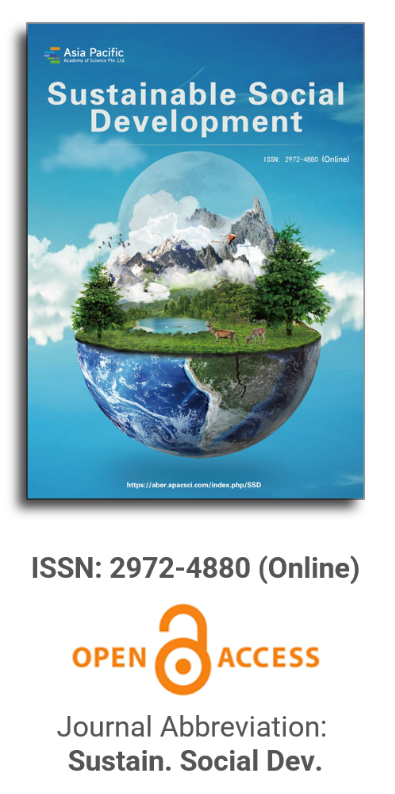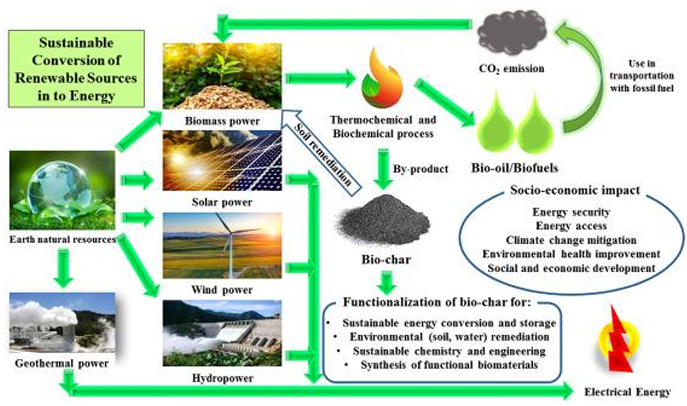
Asia Pacific Academy of Science Pte. Ltd. (APACSCI) specializes in international journal publishing. APACSCI adopts the open access publishing model and provides an important communication bridge for academic groups whose interest fields include engineering, technology, medicine, computer, mathematics, agriculture and forestry, and environment.

Unlocking community value: Building sustainable societies through engagement and well-being
Vol 1, Issue 1, 2023
Download PDF
Abstract
The COVID-19 pandemic has exposed the indiscriminate nature of global interconnectivity, compelling immediate and transformative changes in our daily lives. This crisis has highlighted leadership deficiencies and underscored the broken aspects of our society that were previously taken for granted. As we envision the future, it is crucial to move beyond mere safety and strive for a regenerative society that is fundamentally better. This research paper introduces the concept of the Virtual Living Lab (VLL), a pre-pandemic initiative designed to track and analyze essential lifestyle narratives. Leveraging signal analyses, the VLL identifies and monitors narratives that deeply captivate and engage individuals. By examining these narratives in both the United Kingdom and Japan, we gain valuable insights into the influence of culture and the growing role of ethics in facilitating meaningful transformations. Furthermore, this study recognizes the evolving nature of our network-mediated society, characterized by fluid boundaries between organizations and individuals. Through an exploration of engagement, transformation, and culture, we investigate how these factors shape a thriving society. We also acknowledge the critical role of big data and Artificial Intelligence (AI) in analyzing and understanding these dynamics. During the pandemic, community value emerged as a vital resource for survival. Now, as individuals reevaluate their lives and seek sustainable and meaningful work-life harmony, community value can play an increasingly significant role. This research delves into the intertwined concepts of narratives, engagement, transformation, culture, well-being, communication, and balanced life, shedding light on their collective impact in shaping a thrivable society.
Keywords
References
- Clark AE, Fleche S, Layard R, et al. The Origins of Happiness. Princetown University Press; 2018.
- Helliwell JF, Layard R, Sachs JD, et al. World Happiness Report 2023, 11th ed. Sustainable Development Solutions Network; 2023.
- Layard R, Ward G. Can We Be Happier? Evidence and Ethics. Penguin UK; 2020.
- Arabadjieva K, Countouris N, Fabris BL, Zwysen W. Transformative Ideas-Ensuring a Just Share of Progress for All. European Trade Union Institute; 2023.
- Halden A, Clay A. Regenerative Capitalism: A New Era of Economics. RSA; 2023.
- Layard R, de Neve JE. A Wellbeing Approach to Policymaking. RSA; 2023.
- Radin D. Sentiment and presentiment in Twitter: Do trends in collective mood “feel the future”? World Futures 2023; 79(5): 525–535. doi: 10.1080/02604027.2023.2216629
- Qureshi Z. Rising Inequality: A Major Issue of Our Time. The Brookings Institution; 2023.
- Hofstede G. Culture’s Consequences: Comparing Values, Behaviors, Institutions, and Organizations Across Nations, 2nd ed. SAGE; 2001.
- Goodall A. Credible: The Power of Expert Leaders. Public Affairs; 2023.
- How secretive units tackling Covid disinformation ‘strayed towards censorship’. Available online: https://www.telegraph.co.uk/news/2023/06/02/covid-19-counter-disinformation-policy-forum-censorship/ (accessed on 5 August 2023).
- How to avoid falling for misinformation, fake AI images on social media. Available online: https://www.washingtonpost.com/technology/2023/05/22/misinformation-ai-twitter-facebook-guide/ (accessed on 5 August 2023).
- Business education: Financial training. ESG backlash in the US: What implications for corporations and investors? Available online: https://www.ft.com/content/3f064321-138c-4c65-bbb9-6abcc92adead (accessed on 5 August 2023).
- Beaumont CD, Berry D, Ricketts J. Objectively measuring COVID-19 transformations and identifying scalable policy determinants while explicitly accounting for the influence of Culture. Annals of Social Sciences & Management Studies 2021; 6(2): 66–73. doi: 10.19080/ASM.2021.06.555685
- Baker C, Baker D. An Influencer’s World: A Behind-the-Scenes Look at Social Media Influencers and Creators. University of Iowa Press; 2023.
- Shiller J. Narrative Economics: How Stories Go Viral and Drive Major Economic Events. Princetown University Press; 2019.
- Beaumont CD, Ricketts J. A significant moment in history: A virtual living lab. lifestyle narratives that are shaping our world; the cases of Japan and UK 2019–2020. Sustainability 2020; 12(22): 9658. doi: 10.3390/su12229658
- Beaumont CD, Berry D, Ricketts J. “Engaging with Engagement”: A new communications strategy that provides coherence making companies more competitive and public institutions more agile and accessible. Advances in Journalism and Communication 2021; 9(4): 161–195. doi: 10.4236/ajc.2021.94013.
- Beaumont CD, Berry D, Ricketts J. Technology has empowered the consumer, but marketing communications need to catch-up: An approach to fast-forward the future. Businesses 2022; 2(2): 246–272. doi: 10.3390/businesses2020017
- Beaumont CD, Berry D, Ricketts J. The nature of change has changed. Insightful and timely understanding of what people feel, and think is more important than ever. iBusiness 2023; 15(1): 1–25. doi: 10.4236/ib.2023.151001
- Plutchik R. Emotions and Life: Perspectives from Psychology, Biology, and Evolution. American Psychological Association; 2003.
- Castells M. Networks of Outrage and Hope: Social Movements in the Internet Age. John Wiley & Sons; 2015.
- Beaumont CD, Berry D, Ricketts J. Food sustainability: Virtual living lab helps to identify the important narrative and simplify the complex. Advances in Journalism and Communication 2023; 11(2): 93–105. doi: 10.4236/ajc.2023.112007
- Kaplan AM, Haenlein M. Users of the world, unite! The challenges and opportunities of social media. Business Horizons 2010; 53(1): 59–68. doi: 10.1016/j.bushor.2009.09.003
- Hennig-Thurau T, Malthouse EC, Friege C, et al. The impact of new media on customer relationships. Journal of Service Research 2010; 13(3): 311–330. doi: 10.1177/109467051037546
- Kietzmann JH, Hermkens K, McCarthy IP, Silvestre BS. Social media? Get serious! Understanding the functional building blocks of social media. Business Horizons 2011; 54(3): 241–251. doi: 10.1016/j.bushor.2011.01.005
- Keller KL, Lehmann DR. Brands and branding: Research findings and future priorities. Marketing Science 2006; 25(6): 740–759. doi: 10.1287/mksc.1050.0153
- Popper K. The Open Society and Its Enemies. Routledge; 1945.
- Lewandowsky S, Ecker UKH, Cook J. Beyond misinformation: Understanding and coping with the “post-truth” era. Journal of Applied Research in Memory and Cognition 2017; 6(4): 353–369. doi: 10.1016/j.jarmac.2017.07.008
- Huber M, van Vliet M, Giezenberg M, et al. Towards a ‘patient-centred’ operationalization of the new dynamic concept of health: A mixed methods study. BMJ Open 2016; 6(1): e010091. doi: 10.1136/bmjopen-2015-010091
- Moffitt RA. The negative income tax and the evolution of US welfare policy. Journal of Economic Perspectives 2003; 17(3): 119–140. doi: 10.1257/089533003769204380
- Mende J, Drubel J. At the junction: Two models of business responsibility for modern slavery. Human Rights Review 2020; 21: 313–335. doi: 10.1007/s12142-020-00596-9
- Brynjolfsson E, McAfee A. The Second Machine Age: Work, Progress, and Prosperity in a Time of Brilliant Technologies. WW Norton & Company; 2014.
- Stiglitz J. People, Power, and Profits: Progressive Capitalism for an Age of Discontent. Penguin UK; 2019.
- Gratton L, Scott AJ. The 100-year Life: Living and Working in an Age of Longevity. Bloomsbury Publishing; 2016.
- Bughin J, Hazan E, Ramaswamy S, et al. Artificial Intelligence: The Next Digital Frontier? McKinsey Global Institute; 2018.
- Reimer T. Environmental factors to maximize social media engagement: A comprehensive framework. Journal of Retailing and Consumer Services 2023; 75: 103458. doi: 10.1016/j.jretconser.2023.103458
- Davenport TH, Ronanki R. Artificial Intelligence for the real world. Harvard Business Review 2018; 96(1): 108–116.
- Kumar V, Aksoy L, Donkers B, et al. Undervalued or overvalued customers: Capturing total customer engagement value. Journal of Service Research 2010; 13(3): 297–310. doi: 10.1177/1094670510375602
- Gensler S, Völckner F, Liu-Thompkins Y, Wiertz C. Managing brands in the social media environment. Journal of Interactive Marketing 2013; 27(4): 242–256. doi: 10.1016/j.intmar.2013.09.004
- Holtzhausen D, Zerfass A. Strategic communication: Opportunities and challenges of the research area. In: Holtzhausen D, Zerfass A (editors.). The Routledge Handbook of Strategic Communication. Routledge; 2019.
- Escalas JE, Bettman JR. Self-construal, reference groups, and brand meaning. Journal of Consumer Research 2005; 32(3): 378–389. doi: 10.1086/497549
- Chen H, Chiang RHL, Storey VC. Business intelligence and analytics: From big data to big impact. MIS Quarterly 2012; 36(4): 1165–1188. doi: 10.2307/41703503
- Dhar V, Chang EA. Does chatter matter? The impact of user-generated content on music sales. Journal of Interactive Marketing 2009; 23(4): 300–307. doi: 10.1016/j.intmar.2009.07.00
- Escalas JE, Bettman JR. Self-construal, reference groups, and brand meaning. Journal of Consumer Research 2005; 32(3): 378–389. doi: 10.1086/497549
Supporting Agencies
Copyright (c) 2023 Chris D. Beaumont, Darrell Berry, John Ricketts
License URL: https://creativecommons.org/licenses/by/4.0

This site is licensed under a Creative Commons Attribution 4.0 International License (CC BY 4.0).

Prof. Kittisak Jermsittiparsert
University of City Island, Cyprus






It is with deep regret that we announce the cancellation of the Forum on Sustainable Social Development & Computing and Artificial Intelligence, originally scheduled for June 15, 2025.

